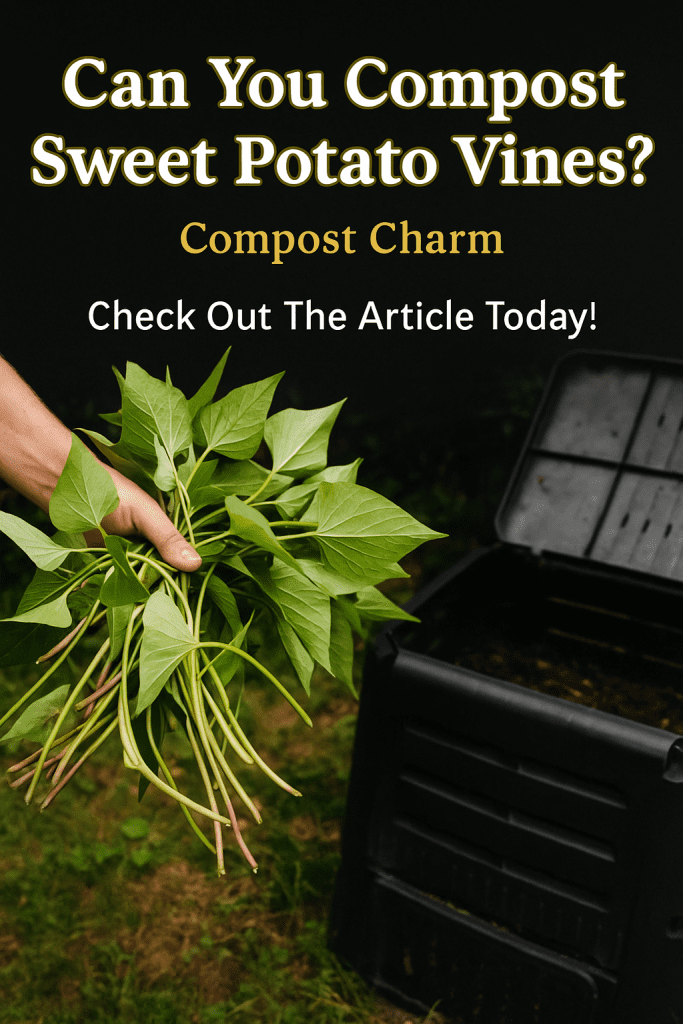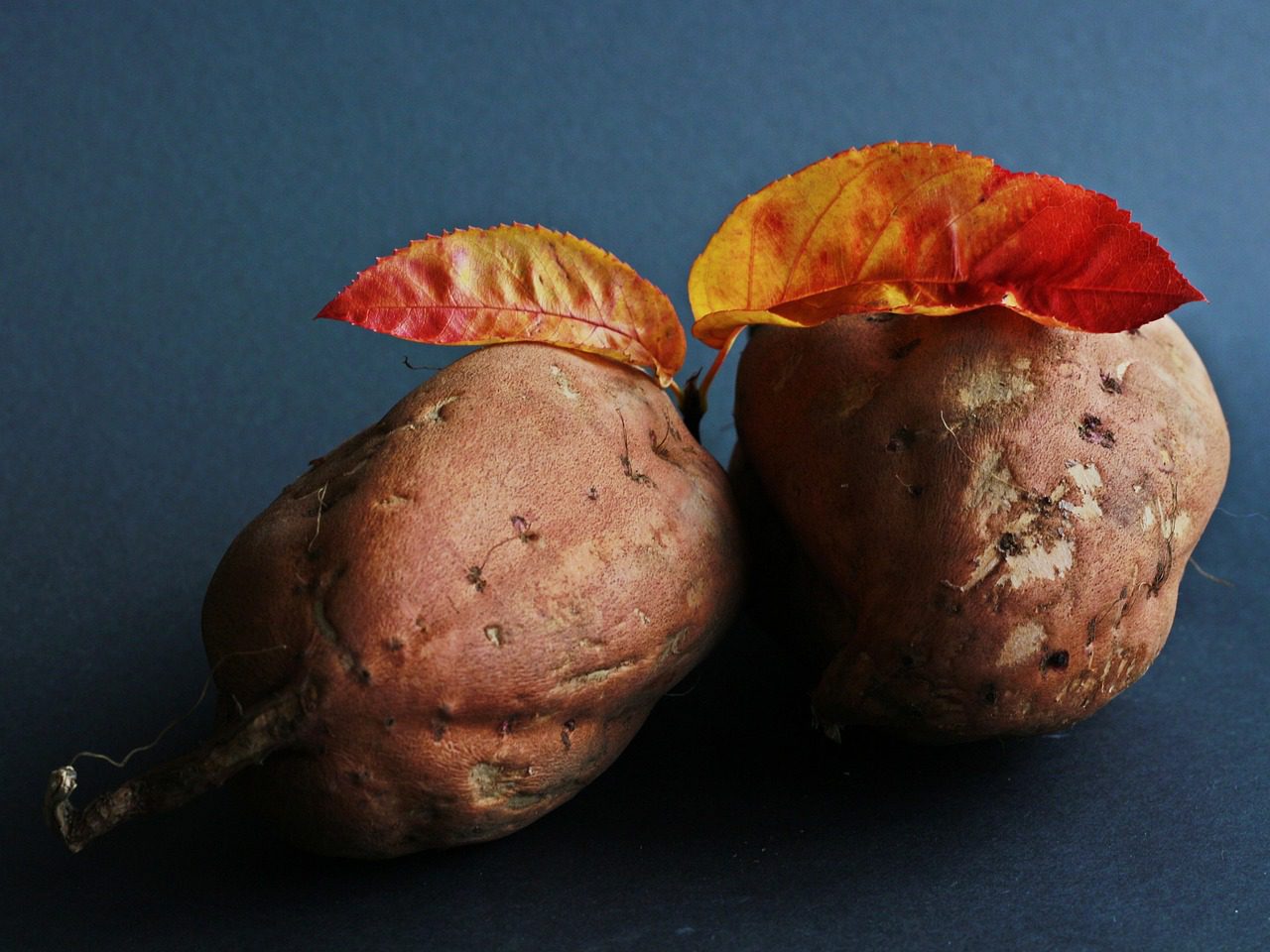Easy Steps for Greener Living
Can you compost sweet potato vines? Yes, and it’s easy to get started. Discover simple steps and tips to safely compost these garden leftovers.
Composting sweet potato vines, along with other kitchen and garden scraps, is a smart way to shrink household waste while creating nutrient-rich compost for your plants.
If you’re passionate about greener living, learning how to compost sweet potato vines is a practical step that packs a positive punch for sustainability.
Composting means turning organic scraps like sweet potato vines into healthy soil, saving space in your bin and helping the planet.
Whether you use a traditional compost heap, a compost tumbler, or even try vermicomposting with worms, breaking down plant material is easier than you think.
If you’re curious about getting started, or want to upgrade your current system, you’ll find clear steps, common sense tips, and friendly advice right here.
Key Takeaways:
- Yes, you can compost sweet potato vines safely and easily.
- Composting is a simple way to recycle kitchen and garden leftovers into valuable soil.
- Anyone can start composting at home using basic tools or methods like vermicomposting or a compost tumbler.
- Composting helps cut down waste and supports a greener garden and planet.
Ready to learn more?
If you want step-by-step help, check out the home composting starter guide for extra tips that make composting easy, fun, and rewarding.

Can You Compost Sweet Potato Vines?
Composting sweet potato vines is not only possible, it’s a simple way to recycle yard waste into valuable soil for your garden.
Whether you’re weeding the patch after harvest or tidying up trailing vines, don’t toss those green trimmings!
When added to a compost heap, compost tumbler, or even your worm bin for vermicomposting, sweet potato vines break down just like most other plant matter.
Let’s look at the basics of composting sweet potato vines and some tips for doing it safely and effectively.

Photo by Marcelo Verfe
Are Sweet Potato Vines Safe for Composting?
Sweet potato vines are safe to compost and play the same role as any other green material in your bin.
They are considered “greens” because they contain moisture and provide nitrogen, which helps balance drier, brown materials like leaves and cardboard.
Whether you use a compost tumbler or a classic heap, tossing in these vines will help speed up decomposition.
However, add only healthy vines. Avoid composting vines that look diseased or infested. Pathogens and pests may survive in a regular compost pile unless it gets hot enough to kill them.
In a standard backyard system, always check that your vines are healthy.
How to Prepare Sweet Potato Vines for the Compost Heap
Preparing your sweet potato vines makes the process smoother and faster. Thicker sections break down more slowly, but a little prep work helps:
- Chop vines into small pieces (2-6 inches is perfect) to increase surface area and speed up decomposition.
- Mix chopped vines with brown material like dried leaves or shredded paper to balance moisture and keep things smelling fresh.
- Avoid adding too many vines at once. Layer them with other materials, just like in a compost cake.
Many gardeners notice that tough vines and thick stems take time to break down. If you use a compost tumbler, chopping vines ensures smoother turning and quicker results.
For an easy composting method comparison, check out the 6 effective composting methods for helpful tips.
Should You Worry About Sweet Potato Vines Sprouting in the Compost?
Sometimes a sweet potato tuber gets left on the vine, or bits root in the pile. This may lead to new shoots, especially in warm weather.
It’s not a big problem—you’re just giving them a chance to start before being mixed in.
- Turn your pile regularly to disrupt sprouting.
- For peace of mind, monitor your bin. If you see shoots, just mix them in.
- Hot composting (reaching at least 55-65°C/130-150°F) destroys most viable roots and seeds.
Many home gardeners on forums and blogs have asked about this, and as noted in this gardener discussion of composting sweet potato vines, a hot pile makes sprouting rare.
How Long Do Sweet Potato Vines Take to Compost?
Compost sweet potato vines break down fairly quickly if you chop them well and keep your pile active.
With regular turning and balanced greens and browns, expect vines to become rich, crumbly compost in 2-4 months. In cooler or low-maintenance bins, it may take a bit longer.
If you’re using worms (vermicomposting), remember they prefer softer, smaller pieces. Give them a little extra time, and don’t overload the bin with dense vines.
For faster speed, a compost tumbler can be handy since it makes mixing the vines with other materials much easier.
Key Takeaways for Composting Sweet Potato Vines
For a quick summary, here’s what to remember when you compost sweet potato vines:
- Sweet potato vines are great “green” material for your compost, whether you use a pile, tumbler, or vermicomposting.
- Cut or chop vines into small bits for quicker breakdown.
- Mix with brown, dry ingredients for best results.
- Avoid putting very thick, woody sections or diseased vines in your home bin.
- Hot composting helps prevent any accidental sprouting.
If you want more clever composting ideas and real-life tips, browse the composting calendar tricks to keep your bin active no matter the season.
FAQ: Composting Sweet Potato Vines
Can you compost sweet potato leaves with the vines?
Yes, sweet potato leaves compost as easily as the vines.
Will the vines cause problems for my compost bin?
Not if you chop them and mix them in. Thick, tangled vines can slow down compost tumblers or make the pile hard to turn, so prepping is helpful.
Can sweet potato vines be added to a worm bin?
Worms can eat sweet potato vines, but give them small, soft pieces in moderation. Monitor your vermicomposting bin so it doesn’t get too full.
Is there a risk of the vines taking over my compost?
Sprouting is rare, especially if you turn the compost often or use hot methods.
For more advice or if you face a unique composting challenge with vines or other garden trimmings, don’t hesitate to use the Ask A Question tool for instant tips and troubleshooting.
How to Compost Sweet Potato Vines Successfully
Composting sweet potato vines is simple and rewarding, as long as you keep things balanced and know your options for different composting styles.
Whether you’re tossing cut vines into a backyard heap, using a compost tumbler, or want to try out worms in a small space, it’s important to understand the mix of materials that keeps your compost cooking.
Let’s walk through easy ways to get your pile thriving and see why even a handful of sweet potato vines can make a big difference in your home composting routine.
Best Practices: Balancing Greens and Browns
A happy compost pile needs the right blend of “greens” and “browns.” In composting, “greens” are fresh, moist materials like sweet potato vines, kitchen scraps, grass clippings, and coffee grounds.
These sources provide nitrogen, which helps feed the microbes responsible for decomposition. “Browns” are dry, carbon-rich ingredients—think dried leaves, cardboard, shredded paper, and straw.
They give structure, help odor control, and provide energy for your compost’s busy microbes.

Photo by Damir Mijailovic
Common mistakes when composting sweet potato vines:
- Adding only greens, resulting in a soggy, smelly pile.
- Using too many browns, which slows decomposition.
- Tossing in woody, thick vine sections without chopping—these take ages to rot.
- Neglecting to turn or mix the pile, leading to slow breakdown and bad smells.
How to get the balance right:
Most compost guides suggest a ratio of about 2-3 parts brown to 1 part green by volume. Don’t stress about being exact—nature is forgiving!
Focus on layering your sweet potato vines with plenty of dry material.
Top tips for a thriving compost pile or bin:
- Chop sweet potato vines into smaller pieces before adding them.
- Layer: Alternate green (vines, veggie peels) and brown (dry leaves, shredded cardboard) as you build your pile.
- Mix and turn: Aerate regularly to give microbes enough oxygen.
- Moisture matters: Compost should feel like a wrung-out sponge—not dripping wet or bone dry.
- Monitor: If your bin smells, add more browns and turn the pile.
Curious how to get your mix just right? For more science-backed tips, see this detailed guide on the proper compost ratio of greens and browns or the home composting basics at the US EPA.
Hungry for step-by-step instructions?
The compost layering and method guide has extra advice for balancing your pile, whether you use a heap, tumbler, or bin.
Compost Tumblers and Vermicomposting with Sweet Potato Vines
If you have limited space, don’t worry—you don’t need a giant yard to compost sweet potato vines!
Compost tumblers and vermicomposting bins are perfect options for anyone with a small garden, patio, or even a balcony.
How compost tumblers work:
A compost tumbler is a sealed container that you rotate to mix your compost easily. This speeds up decomposition, keeps everything tidy, and helps odor control.
Tumblers are great for chopped sweet potato vines because they blend quickly with other scraps, and you can turn them without fuss.
- Small footprint: Ideal for tight spaces.
- Faster results: Mixing is easy, and even tough vines break down faster when chopped.
- Clean and pest-resistant: No digging or messy piles.
For practical tips, see this beginner’s guide on how to use a compost tumbler for kitchen and garden scraps, or try these tips for starting composting in a tumbler.
Vermicomposting with sweet potato vines:
Vermicomposting is the art of using worms to break down your food scraps.
Red wigglers are the stars in a worm bin, but you need to prep your sweet potato vines to keep the worms happy.
- Chop vines into small, soft pieces.
- Add them in small amounts so worms can munch at their own pace.
- Avoid overloading the bin with tough stems.
Worms love variety. Mix sweet potato vines with softer greens for balance. Curious if worms thrive with sweet potato ends?
Check out this real-life worm bin experiment where the vines even tried to sprout in the bin!
Looking for more bin-friendly composting choices?
The home composting starter guide covers everything from beginner mistakes to picking the perfect bin for small homes.
Key takeaways for composting sweet potato vines in tumblers and worm bins:
- Chop vines well for faster compost.
- Keep a good mix of greens and browns, no matter your method.
- Use a tumbler or worm bin for odor-free composting in small spaces.
- Don’t overload with tough, woody vines—keep it balanced and simple.
With these smart, space-saving tools and the right green-brown balance, compost sweet potato vines can transform from garden trimmings into nutrient-rich soil for your next planting season—no matter your space.
Common Challenges and Troubleshooting Tips
Composting sweet potato vines is straightforward, but even the most enthusiastic composter can face a few hiccups along the way.
From soggy piles to unwelcome pests, knowing what can go wrong (and how to fix it) keeps your composting journey cheerful and stress-free.
Let’s explore some of the bumps you might hit when you compost sweet potato vines and learn simple fixes to keep your pile thriving.
 Photo by Tyas Wahyu P.
Photo by Tyas Wahyu P.
Pile is Soggy or Smelly
Too many green vines or a lack of airflow can quickly turn a compost pile into a smelly, wet mess.
Sweet potato vines hold a lot of moisture, so balance is key.
- Add extra dry browns like straw, cardboard, or dried leaves.
- Mix or turn the pile to add oxygen and prevent odor.
- Make sure your compost heap drains well and isn’t sitting in standing water.
If your pile smells like rotten eggs or sour garbage, it’s gone anaerobic. This fix is as simple as adding browns and giving it a good stir.
As noted in this compost troubleshooting guide, regular turning is the best way to reactivate your pile’s microbes and avoid the dreaded stink.
Vines Aren’t Breaking Down
Sometimes, compost sweet potato vines stay tough and stringy much longer than expected, especially if they’re added in big chunks.
- Chop vines into small pieces before composting.
- Mix them thoroughly with softer greens and browns.
- Turn or aerate regularly (especially in a compost tumbler) to keep everything breaking down.
If your compost seems stuck, it may be too dry or lacking nitrogen.
Try adding a handful of fresh grass clippings or a little extra kitchen waste for a boost.
Pests and Critters in the Pile
No one wants to open their compost bin and see a crowd of bugs or surprise visitors. Pests are usually attracted by unbalanced piles—especially if there’s too much wet material or leftover kitchen scraps.
Simple prevention:
- Avoid adding cooked food or overly sweet scraps with your vines.
- Cover fresh greens, including sweet potato vines, with a layer of dry browns.
- Use sealed bins or a compost tumbler if wildlife is a concern.
If you do spot critters, don’t panic!
Tidy up, add more dry cover, and keep turning. For more about preventing pests and possible garden visitors, the article on common problems with sweet potato vines gives extra tips for a pest-free garden.
Sprouting Vines in the Compost
Believe it or not, it’s possible for sweet potato vines or tiny tubers to sprout inside a cozy compost pile. Warmth and moisture can convince these little survivors to grow where you least expect it.
- Turn the pile often to break up sprouts.
- Hot composting kills off most roots and prevents regrowth.
- For stubborn sprouts, just bury them deeper in the pile or chop before composting.
Gardeners often find that sprouts are more of a funny surprise than a real problem.
Hot composting systems and frequent mixing make it easy to prevent sweet potato vines from coming back to life.
Compact or Matted Vines Make Mixing Difficult
Sweet potato vines can get tangled, especially if you toss them in whole. A tangled pile is hard to turn and can slow down composting.
- Cut or tear vines before adding.
- Mix each new batch of vines with plenty of dry material to avoid clumping.
Compost tumblers are extra helpful here, as regular spinning can break up mats and blend materials.
If you’re comparing different approaches, see these handy options for effective composting methods for pros and cons.
Common Signs Your Compost Needs Attention
Watch for these common issues to keep everything moving in the right direction:
- Compost is wet and swampy: add more browns and turn frequently.
- Vine pieces refuse to break down: chop smaller or add more greens.
- Pile feels cold and inactive: give it a turn and check for moisture.
- Unwanted sprouts: mix thoroughly and use hot compost methods.
For DIY fixes and extra troubleshooting checklists, the detailed breakdown at How to Fix Common Compost Problems covers every stage from slow piles to runaway smells.
Key Takeaways for Troubleshooting Compost Sweet Potato Vines
Keep these practical steps in mind when working with sweet potato vines:
- Always chop vines for faster breakdown.
- Use the right mix of greens and browns so piles stay active and odor-free.
- Turn your heap or compost tumbler often—air is your best friend.
- If you find pests or critters, adjust your mix and keep the bin tidy.
- Sprouting is normal but easy to prevent with regular maintenance.
Everyone faces compost hiccups now and then—even seasoned gardeners.
If you need a quick answer to a quirky problem, the Ask A Question tool is available 24/7 for instant tips and peace of mind.
FAQ: Troubleshooting Sweet Potato Vine Compost
Why isn’t my sweet potato vine breaking down?
Most likely, the pieces are too big or the pile lacks nitrogen greens. Chop smaller and mix in more greens.
How can I stop my pile from smelling bad?
Mix in more dry browns and turn the heap or tumbler every few days for plenty of fresh air.
What if I see lots of bugs or animals?
Cover all greens with browns, avoid food like meat or dairy, and use lidded bins if needed.
Is sprouting in the compost a problem?
Not usually, but turning and hot composting keeps sprouts under control.
Composting is never perfect, but with a little attention, every pile can become great compost. Stick with it and you’ll find even sweet potato vines can turn into garden gold.
Key Takeaways and Sustainable Living Tips
Learning how to compost sweet potato vines connects everyday choices to bigger changes in our environment.
Composting isn’t just tossing scraps in a bin—it’s a simple, powerful way to recycle, cut waste, and give back to your garden and the planet.
Let’s look at some clear takeaways and easy steps to help sweet potato vines (and you!) become heroes for sustainable living.

Photo by SHVETS production
Key Points to Remember When You Compost Sweet Potato Vines
When you compost sweet potato vines the right way, you get rich, crumbly compost plus a cleaner planet. Here’s what matters most:
- Chop sweet potato vines before adding. Smaller pieces break down faster and are easier to mix.
- Balance greens and browns. Remember, sweet potato vines count as “greens.” Mix with dry leaves, cardboard, or newspaper for happy microbes.
- Try different composting methods. Compost tumbler, classic pile, or even vermicomposting—pick what fits your space.
- Turn or aerate your pile often. More air means faster compost and fewer smells.
- Watch for pests and sprouting. Cover greens with browns, and turn your pile if you spot any new shoots.
Keep a sticky note by your compost bin and remind yourself: “Chop, mix, turn—compost sweet potato vines earn!”
If you’re just starting or want deep-dive tips for common home waste, check out the Don’t Toss It – Composting Tips for even more kitchen and garden inspiration.
Daily Actions for Sustainable Living
You don’t have to overhaul your life to make a difference. Start with these small changes:
- Collect kitchen scraps daily. Keep a counter bin or bowl handy for sweet potato peels, banana skins, coffee grounds, and even those vine trimmings.
- Chop and drop in the garden. Too busy for a bin? Chop sweet potato vines into small bits and tuck them under mulch or soil in your garden beds.
- Compost in small spaces. No yard? Use a compost tumbler or try vermicomposting with worms. These options fit perfectly on patios or balconies.
- Rotate “compost chef” duties. If you live with family or roommates, make compost care a shared job—everyone learns and wins.
- Reuse before you toss. Explore creative ways to use up food and garden scraps. Sweet potato vines can sometimes double as animal feed or mulch.
- Celebrate your compost. Grab a handful of finished compost and see (and smell) the results of your work. It enriches soil and boosts garden growth.
It can be fun and satisfying to keep waste low and soil rich. You’re not just making compost, you’re making a habit that matters.
For even more simple wins, check out the Compost Layering Technique Explained guide for ways to layer greens and browns that reduce odors and speed up breakdown.
Build Habits for Long-Term Sustainability
Tiny habits create major change over time. Try these:
- Set a reminder to turn your compost once a week.
- Involve kids by letting them “feed” the bin—composting makes science hands-on and fascinating.
- Make a game of spotting what else can compost, from paper napkins to wilted flowers.
- Mark compost bin “birthdays” on your calendar to celebrate your progress (and collect fresh compost for your plants!).
Adding compost sweet potato vines is just the start—when you focus on little habits, sustainable living feels natural and rewarding.
For extra confidence, check the Composting Tips Guide whenever you hit a snag or want new ideas. There’s always a new trick to try!
Summary
- Composting turns sweet potato vines and other kitchen scraps into rich soil.
- Chop vines small, balance green and brown materials, and remember to turn your pile or bin.
- Both compost tumblers and vermicomposting help recycle waste, even in small spaces.
- Start with simple daily actions—every bit adds up over time.
FAQ: Sustainable Living and Composting
What’s the easiest way to start composting at home?
Gather scraps, get a small bin or compost tumbler, and start with kitchen waste. Mix in browns like leaves or shredded cardboard for fast, odor-free compost.
Do sweet potato vines require special composting steps?
No, but chopping them first and mixing with dry materials always helps. Avoid weeds or diseased parts.
Can kids help with composting?
Absolutely! Composting is safe and easy for all ages, and it’s a fun science experiment with real rewards.
Will composting really reduce waste at home?
Yes—a typical home can cut bin waste by one-third just by composting food and yard scraps.
What do I do if my compost pile smells bad?
Add more browns (dry stuff) and turn the bin for better air. The smell disappears fast when the balance is right.
Small steps with compost sweet potato vines can lead to big change for your garden and your world. For more support, explore the How to Start Composting at Home guide—your compost journey starts today!
Summary & FAQ
As you wrap up your exploration on how to compost sweet potato vines, it’s helpful to step back and see what matters most.
Composting sweet potato vines is a satisfying, eco-friendly choice that keeps your bins less full and your soil more lively.
Whether you use a simple heap, a trusty compost tumbler, or a worm bin for vermicomposting, adding sweet potato vines into your mix brings your compost and your garden to life.

Photo by Matheus Bertelli
Adding sweet potato vines to your compost is as simple as chopping, mixing, and turning. It fits right into any composting routine, whether you’re just starting out or you’re the neighborhood compost pro.
The real magic comes from mixing those green vines with plenty of brown, dry material. That mix keeps things balanced, reduces smells, and speeds up breakdown.
Turning the pile or spinning the compost tumbler helps create air pockets, which keep compost cooking along.
If you want truly rich compost and fewer headaches, always avoid adding weeds and diseased plants. Sprinkle in kitchen scraps, used coffee grounds, or shredded paper for even better results.
After a few months, you’ll notice your leftover vines have turned into earthy goodness—ready for the next planting season.
For more practical tips to start composting at home, explore the Starter Guide for Home Composting.
It’s packed with easy advice and helps you choose between classic compost heaps, tumblers, or worm bins.
Key Takeaways
Let’s sum it up with the main points you should remember about composting sweet potato vines:
- Compost sweet potato vines as “greens” (fresh, moist material) for a nutrient boost.
- Chop vines to help them break down quickly, especially in compost tumblers or worm bins.
- Mix with browns (like leaves or cardboard) for a balanced, odor-free pile.
- Turn or aerate compost often to add oxygen, prevent smells, and speed decomposition.
- Both compost tumblers and vermicomposting bins make composting easy in any space, big or small.
- Finished compost from your pile will enrich garden soil, cut waste, and help plants thrive.
- If you run into trouble, the Ask A Question tool offers quick, friendly support for all your compost challenges.
FAQ: Compost Sweet Potato Vines
Here are some of the most common questions about compost sweet potato vines, composting tips, and tricks for happy bins.
Can I compost only sweet potato vines, or should I add other materials?
It’s best to add both greens (like sweet potato vines) and browns (such as dried leaves or shredded paper). Compost piles need a mix so microbes can do their job.
Pile up just greens, and you could end up with a stinky, slimy mess.
Are sweet potato vines safe for compost tumblers and worm bins?
Yes! Just chop them into small pieces, mix them with a few browns, and avoid stuffing in tough, thick sections.
Both compost tumblers and vermicomposting bins welcome these vines, as long as the mix is balanced.
Will vines regrow or sprout in my compost?
Sprouting can happen if tubers or bits of vine with roots get into the compost, especially if conditions are warm.
If you see shoots, just mix them in. Hot compost heaps and regular turning quickly take care of sprouting. Want to learn from gardeners who’ve had “volunteer” vines pop up?
See the fun story on how one gardener handled sweet potato sprouts in their heap.
Can I compost diseased or pest-infested sweet potato vines?
It’s safest to avoid composting any vines that look sickly or are crawling with pests. Unless you use a hot compost system that reaches high temperatures, some garden problems can survive and spread.
Play it safe by sending those bad vines to the yard waste bin.
How long does it take for sweet potato vines to break down?
Chopped well, sweet potato vines usually turn into finished compost within a few months in an active, well-turned pile or tumbler.
In worm bins, give worms a bit more time, but they’ll happily munch away if you don’t add too much at once.
My compost goes soggy with sweet potato vines—what should I do?
Mix in more browns! If your compost feels wet, add extra dry leaves, cardboard, or shredded paper, and give it a good turn with a fork or spin in the tumbler.
A healthy compost pile should feel as damp as a wrung-out sponge.
Where can I get more composting tips for other tricky materials?
For advice on everything from pine needles to composting cooked food, browse the practical tips in the Pine Needle Compost Guide.
Composting really is for everyone—and nearly everything organic.
What’s the best way to troubleshoot problems if my compost pile isn’t working?
If you notice bad smells, slow breakdown, or unwanted critters, check your mix and give everything a good turn.
For more troubleshooting, the Ask A Question tool has quick answers for nearly every compost conundrum.
Sweet potato vines don’t just feed the compost—they make composting more rewarding.
When you chop, mix, and care for your pile, even these tangled greens can turn into black gold your garden will love.
Compost sweet potato vines, keep it balanced, and watch your garden thrive!





